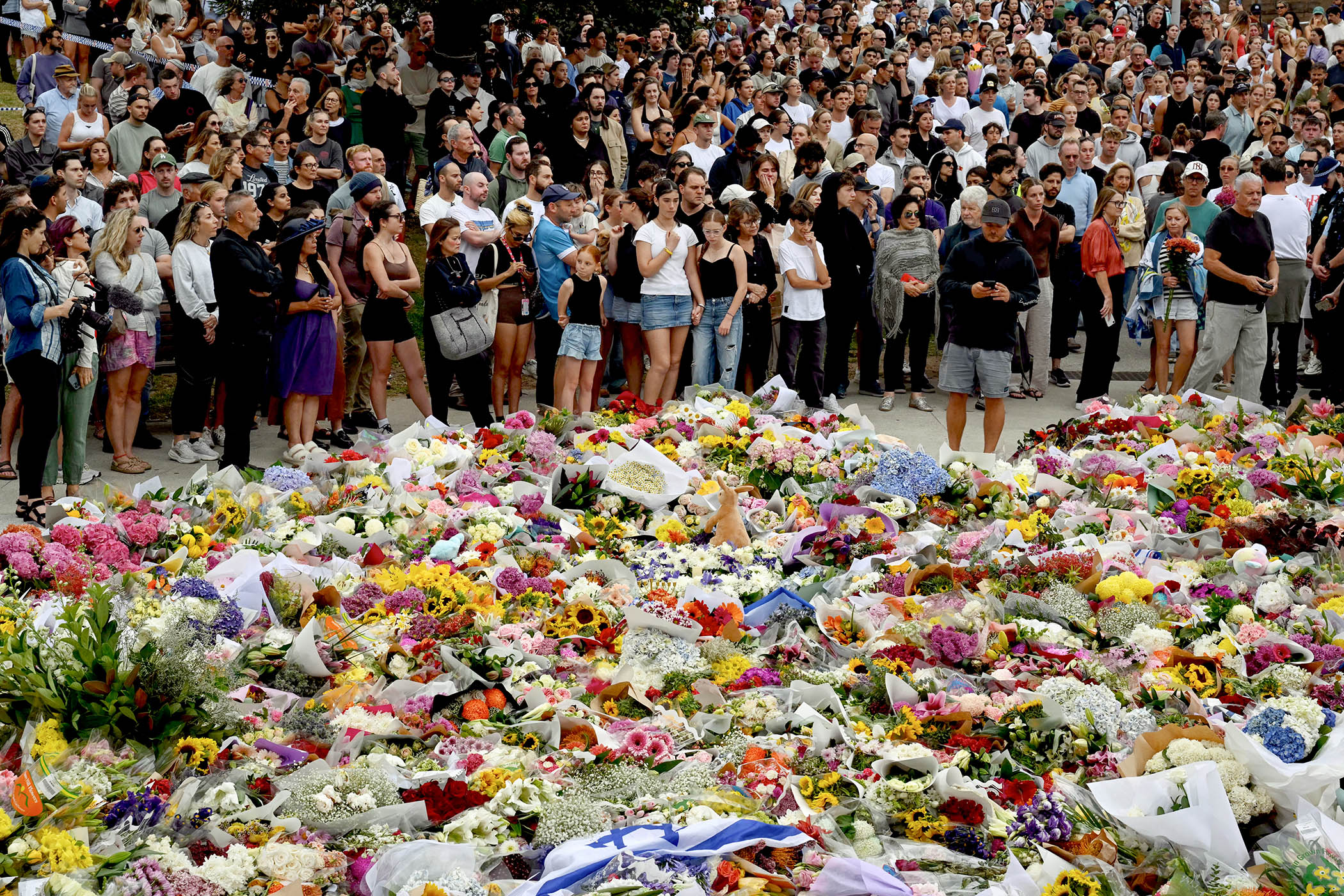Everywhere you looked, there was teal – volunteers wearing teal hats and T-shirts, crammed into a pub in suburban Melbourne on election night 2022, holding aloft teal signs and banners. There was even a limp arch of teal balloons strung across the makeshift stage in the beer garden.
The colour – a mix of the blue from Australia’s rightwing Liberal party and its Greens – had come to symbolise an insurgent movement of independent political candidates challenging the country’s political duopoly, and what they saw as the conservative government’s refusal to take the climate crisis seriously.
Climate loomed large in that election, with memories of Australia’s black summer of 2019/20 – when bushfires burned through an area the size of the UK – still raw. Inaction on climate had become a flashpoint, embodied by an image of then prime minister Scott Morrison holding up a lump of coal in parliament.
It was late when Monique Ryan, a paediatric neurologist, finally made her way to the stage to address her teal sea of supporters. Standing before them, she offered a confession: “I didn’t write a victory speech.”
Ryan had launched her campaign for one of the country’s safest and most affluent conservative seats just a few weeks earlier. Her candidacy – as someone with no political experience or national profile – was at first greeted with a smirk. The Liberals had comfortaby held this seat, Kooyong, for nearly 80 years.
Related articles:
But the ballots on election night told a remarkable story. Ryan had pulled off what many thought impossible. Not only had she taken Kooyong, she’d also toppled Australia’s treasurer, Josh Frydenberg – a man many believed would one day be prime minister.
“We started this because we wanted action on climate change, and we felt it was the most important challenge of our time,” she riffed. “The government wasn’t listening to us … so we changed the government.”
The cheer from the crowd bellowed like a war cry.
Ryan was on the crest of a wave that swept seven of these teal independents into Australia’s parliament in 2022. The rightwing coalition fell, ushering in a centre-left Labor administration that promised to cut emissions further. With the Greens also gaining their highest-ever vote, it looked as if Australia was finally facing up to the reality of climate change.
Since then, the country has been battered by more fires and floods – most notably the deluge that inundated the east coast in 2022, killing seven people and damaging 5,000 homes. But as Australia prepares to go to the polls again on 3 May, climate is no longer at the top of most voters’ minds. As in so many other countries, the cost of living crisis has dramatically changed voters’ priorities.
“Climate has fallen down the agenda,” says Rachel Huntley, director of research at consultancy firm 89 Degrees East. “But so has everything else … every single issue, other than cost of living, has fallen.”
Research from the Australian National University shows that dealing with the global climate slipped from a top five issue for voters in 2022 to something that only a third say is a priority for them in 2025.
Twenty-year-old Alexa Stuart says that, for younger voters, it feels as if politicians are ignoring the elephant in the room – Australia’s continued place as one of the top three global exporters of both coal and gas. And this sentiment isn’t insignificant, given that, in 2025, gen Z and millennial voters will, for the first time, make up the majority of voters in Australia.
“I remember the last election – I felt so hopeful,” says Stuart, who first voted in 2022. “I remember that, when the prime minister was asked what he wanted his legacy to be, he said climate action. He said he wanted to end the so-called ‘climate wars’.”
Instead, Stuart, who is part of the Rising Tide climate movement, believes that Australia is experiencing a “new form of denial” where politicians claim to be acting on climate without addressing the fundamental issues, such as exports.
Stuart made headlines this month, when she crashed a press conference where prime minister Anthony Albanese promised a $1bn (£480m) funding boost for mental health.
“Mr Albanese, you say you care about young people but since getting elected you’ve approved 33 new coal and gas mines,” she yelled as she was pushed from the building by security.
The prime minister encouraged the media present to ignore protesters saying, that “it just encourages them”.
“I have been anxious about climate since I was 15. And since then, I’ve met with MPs, I’ve written countless letters, signed petitions, protested in the ‘right’ way … and still we are seeing young people’s voices being ignored,” Stuart says. “As soon as I saw the prime minister, all these years of anger and frustration at being silenced, it all just came out.”
Stuart says that, to younger voters like her, the teals seem more middle-of-the-road than progressive. “But I think people are looking to options that aren’t the major parties, and they’re looking for representatives who will act strongly on climate.”
Nick Biddle, head of the school of politics at the Australian National University, agrees on the appetite for something different. He has studied the electorate for years, leading a survey that has followed the moods of 3,500 voters over time.
“What we found is that, for the most part, people are more pessimistic – less optimistic than they have been at any time we’ve asked these questions,” he says.
“We ask a pretty simple question: whether you think the lives of today’s children will be better or worse compared to your life.”
The question was first asked in 2008, when the majority responded that the lives of their children would be better than their own. “But when we asked in January 2025, we had more people who said that lives would be worse … it’s almost 60% who thought life would be worse, compared with about 23% who thought life will be better for today’s children.”
‘The government wasn’t listening to us so we changed the government’
Monique Ryan, Kooyong MP
Economic pessimism, says Biddle, is leading voters away from Labor and the Liberals. They aren’t flowing towards the Greens, who have seen support collapse, but are going to the independents, including the teals.
All the teals remain committed to pushing the government to take up a 75% emissions reduction target for 2035 – far above the Albanese Labor government’s 43% target. But even they are shifting their messaging, focusing more on the cost of living.
The political funding body Climate 200, which bankrolled many of the teals in 2022, is backing 35 teal candidates this year, and its chief executive, Byron Fay, is quietly optimistic.
“It’s all really tight out there,” he says, “but there are a whole lot of new communities trying to see independents elected …
“We’ve had decades of major-party governments, and we haven’t had the action we need on our climate crisis, our cost of living crisis and housing crisis. People are sick of it and want to find another way of doing politics.”
He says the presence of well-funded campaigns against the independent candidates shows how worried powerful factions are about their rise.
“It’s telling that the main attack vehicle against [the independents] is a coal lobby front group called Australians for Prosperity,” he says, likening the group to Americans for Prosperity, a libertarian conservative political advocacy group in the US started by the Koch B brothers.
Fay says the Australian group is “spending millions and millions of dollars on attack ads and flyers and billboards”.
The teals’ own funding has also been under the microscope. Climate 200 raised $13m last time, and finance minister Katy Gallagher accused her teal opponent of bringing “big money” politics into the race, by spending “up to $2m” on his campaign in the runup to this election.
A hung parliament remains a realistic prospect – Labor has a majority of just two seats. If that happens, the teals – however many end up in parliament – may hold the balance of power. As to which major party they would back in a hung parliament, the teals have played their cards close to their chests – beyond Ryan saying that she wants to see more tax extracted from offshore oil and gas producers.
A hung parliament could be the teals’ moment to bring the climate crisis back to centre stage. Ambitious reforms, like the 75% percent emissions reduction target the teals have been gunning for, or an end to new coal and gas mines in Australia, may well be on the negotiating table. If one of the major parties can still scrape through with a majority, though, the teals could be waiting years for the chance to fundamentally reshape Australia’s climate policy.
Photograph James Brickwood / Sydney Morning Herald via Getty Images


